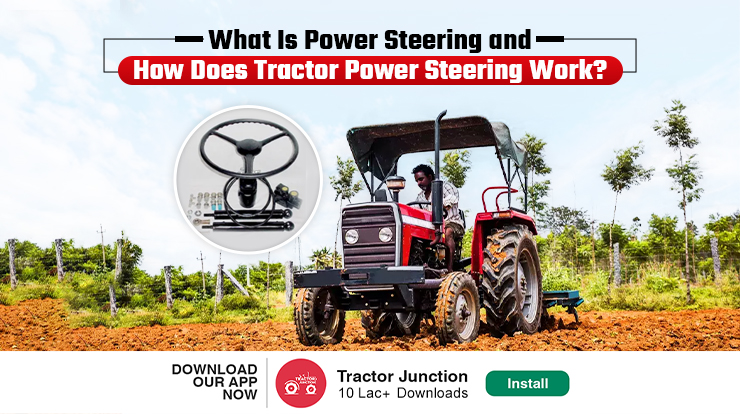
Ever tried to drive a tractor without power steering? It’s like trying to walk barefoot in a muddy area! Power steering is a system that helps make turning tractor wheels much easier. Without it, steering would be a real struggle, especially when maneuvering around tight corners.
Having this installed majorly benefits the farmers, right from reducing fatigue, increasing productivity, to ensuring ease of control, particularly in challenging work conditions. E. McCarthy introduced the 1st power steering back in 1900.
The first power steering system was developed in 1900 by Robert E. McCarthy Twiford. However, it only gained popularity with the Cadillac Chrysler Imperial, in 1951, America.
So, what exactly is power steering, and how does it work? Let’s find out all the details!
What is Power Steering in a Tractor?
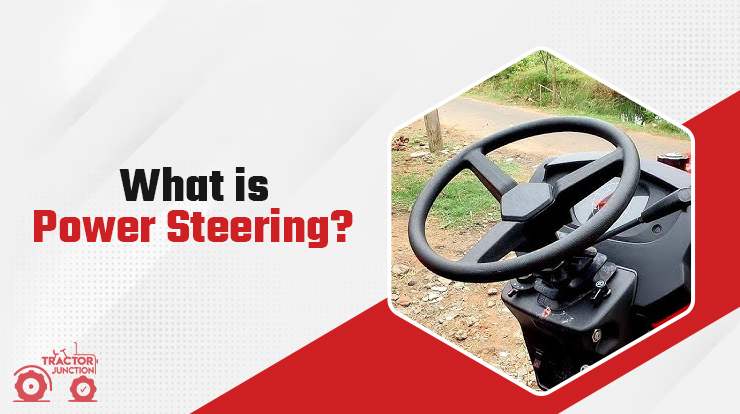
In tractors, power steering facilitates easier wheel rotation by using a power source. It may be simpler to turn the wheel with power steering, particularly when moving slowly or towing large objects. Now, to help turn the front wheels, power steering can use hydraulics, which is the application of fluid pressure or electric power.
Components of Tractor Power Steering System
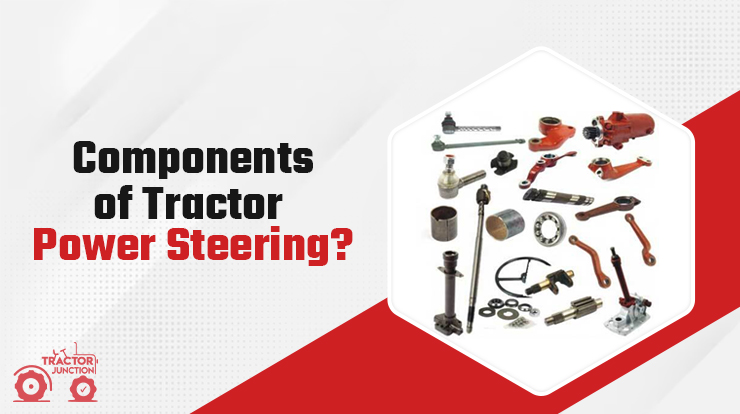
Power steering comes attached with a hydraulic power steering, including components: a pump, cylinder, and control valve. It also has an electric power steering which comprises an electric motor, steering column along with a control module. Learn more about the components below:
Hydraulic Power Steering:
- Hydraulic Pump: This pump directs fluid to assist with steering.
- The Hydraulic Cylinder: It functions by exerting force on the tractor’s framework to turn the wheels.
- Steering Control Valve: The valve controls the liquid flow to the cylinder.
Electric Power Steering:
- Electric Motor: It assists in turning the wheels.
- Steering Column: The part of the tractor where you hold onto the steering wheel.
- Control Module: This controls how much assistance the electric motor provides.
How Does Power Steering Work?
The power steering tractor system enables the movement of front wheels in response to the steering wheel. This setup requires multiple components to work together, to make steering easier and precise. Want to learn more about how it works? There are two types of power steering systems:
Hydraulic Systems:
Fluid power is used by a hydraulic power steering system (HPS) to facilitate steering. When you turn the wheel, pressurised hydraulic oil is sent through tubes to a cylinder that contains a piston by means of an engine-driven pump. Power steering oil multiplies steering force by increasing piston performance and aids in wheel rotation.
Electric Systems:
Here, hydraulic power is substituted by an electric motor. A computer module uses the motor to apply assistive torque after sensors measure the torque and position of the steering wheel. The amount of assistance needed for driving conditions varies. Moreover, EPS systems have advantages like better fuel efficiency, simpler manufacturing, and the ability to add driver assistance features.
Comparing The Two Power Steering Systems:
Electric power steering depends on an electric motor, whereas hydraulic power steering uses fluid pressure to help in steering. Older tractors frequently use hydraulic systems for powerful assistance, although they may lack precision. Newer tractors frequently come equipped with electric systems, providing improved steering accuracy and a smoother driving experience. They are also typically more effective and need less maintenance. In general, each system has its own benefits and is appropriate for various tractor uses.
Benefits Of Power Steering In Tractors
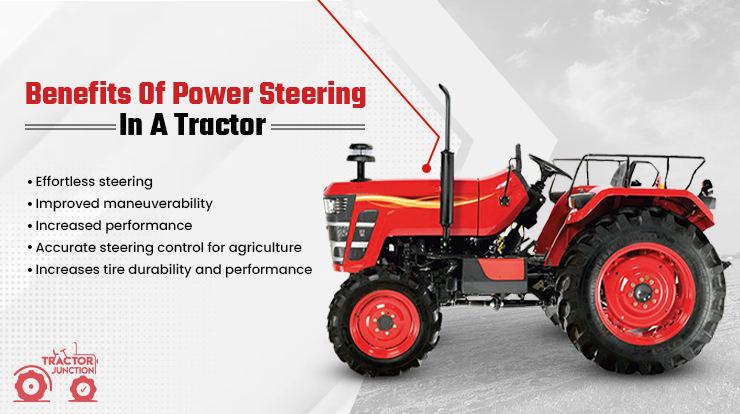
The tractor with power steering is highly manoeuvrable, non-fatiguing for operators, safe, productive, and accessible to farmers of all physical abilities. Learn more about it below:
- Effortless steering: Farmers can move the steering wheel with minimal effort, reducing fatigue. Tasks can completed more efficiently and with greater accuracy.
- Improved maneuverability: Power steering provides precise and smooth handling, making it easier to navigate the field and around obstacles.
- Increased performance: By reducing fatigue and improving efficiency, power steering allows users to cover more ground in less time. Furthermore, improved precision in tasks such as planting or irrigation reduces seed, fertilizer, or chemical waste.
- Accurate steering control for agriculture: Good control of the tractor reduces the possibility of accidents and improves overall safety in the field.
- Increases tire durability and performance: Power steering helps extend tire life and improve performance by improving tire-to-ground contact and preventing tire skidding due to compliance problems and around the reason.
Difference Between Power Steering And Normal Steering
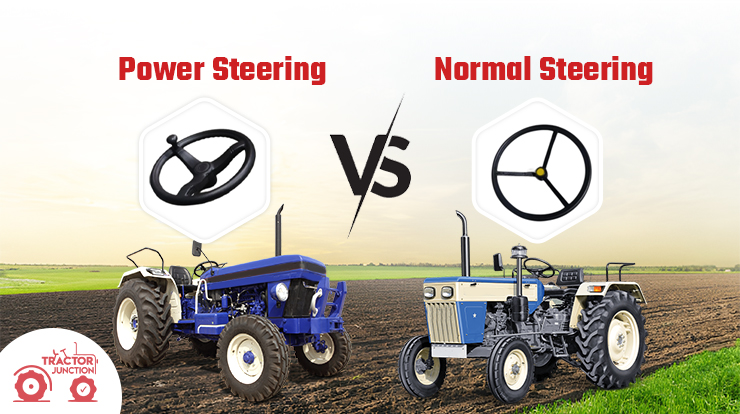
Power steering helps you steer with less effort and uses special assistance, while normal steering requires you to use your muscles to turn the wheel without any help. Learn more about power steering vs normal steering below:
| Aspect | Power Steering | Normal Steering |
| Effort Required | Less effort is needed to turn the steering wheel. | More physical effort is required to steer. |
| Maneuverability | Provides smoother and more precise control. | Control may feel heavier and less precise. |
| Operator Fatigue | Reduces operator fatigue during long hours. | Operators may experience more fatigue. |
| Accessibility | Easier for operators of varying physical abilities. | This may pose challenges for some operators. |
| Cost | Generally higher cost due to added components. | Lower cost as it typically lacks power assistance. |
Choosing The Right Power Steering System For Tractors
Certain factors like brand, model along with power steering tractor price become crucial when choosing the right power steering system for tractors. Some of the best available choices in the same are Mahindra tractor power steering, Swaraj tractor power steering, tractor power steering from Sonalika and John Deere.
So, it’s important to consider these brands when researching and comparing power steering systems to find the best fit for your needs.
For instance, Swaraj 735, 834 XM, and Eicher 380 power steering prices may vary depending on the model and additional features. Massey Ferguson models like 1035 DI, 241, and 245 also come with power steering options, each with its price tag.
Mahindra 275 DI XP Plus and Eicher’s 242 are other examples of tractors equipped with power steering catering to diverse needs and budgets. Prices may fluctuate based on factors such as horsepower, technology, and additional functionalities.
Conclusion
Tractors with power steering equipped with an essential system that facilitates and optimizes steering, offering numerous advantages to farmers. Power steering improves safety and operator fatigue while increasing productivity and mobility by lowering steering effort. It is crucial to take into factors like the significance of effective steering in agricultural machinery and hydraulic power steering for farm equipment.
Tractor steering enhancement technology greatly improves driving efficiency and reduces operator fatigue. Investing in the right power steering system can dramatically increase the overall performance and handling of tractors, ultimately resulting in higher yields and profitability in the agricultural industry.
Related Blog
What is Front PTO Tractor?
What is Tractor PTO?
